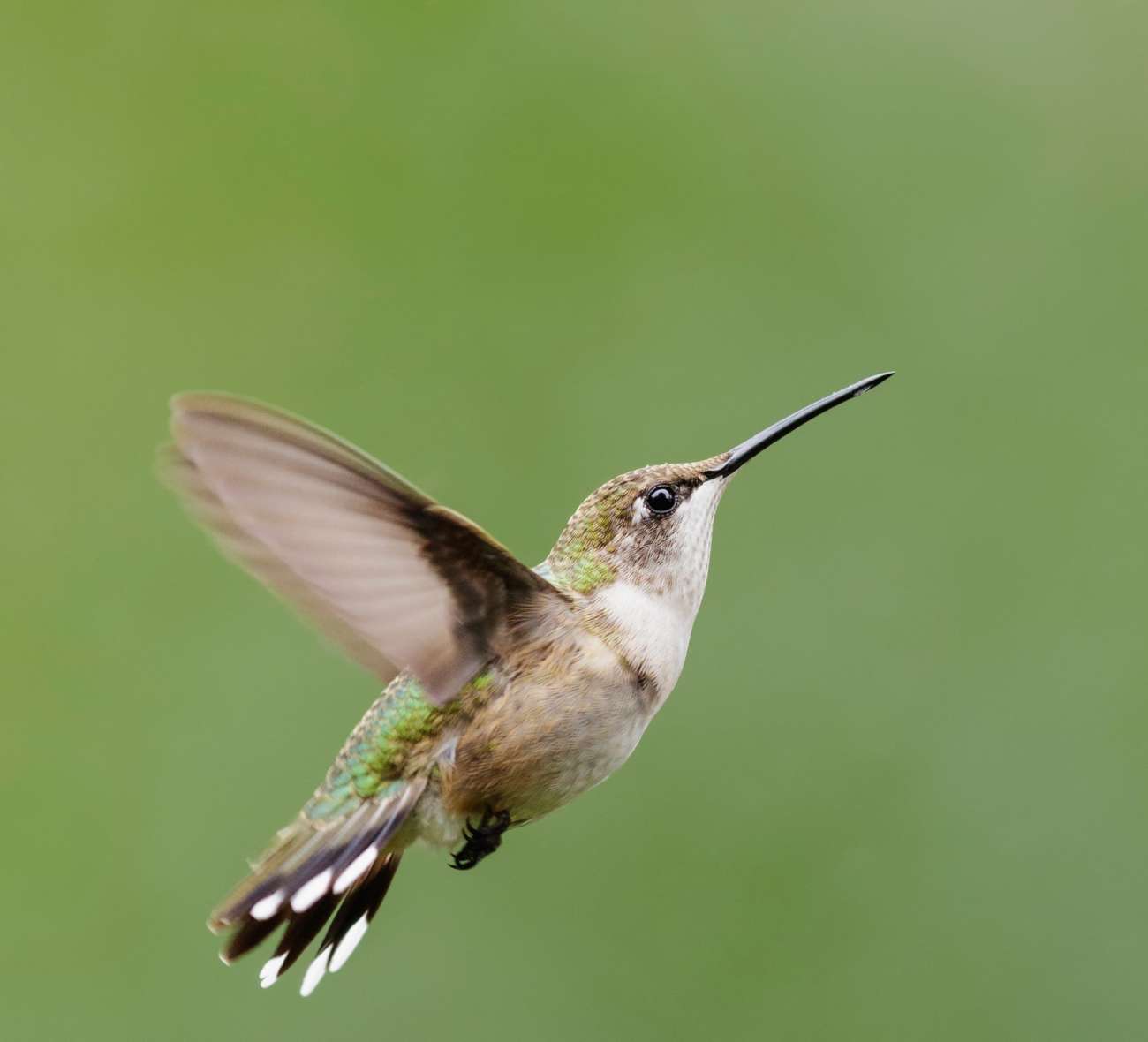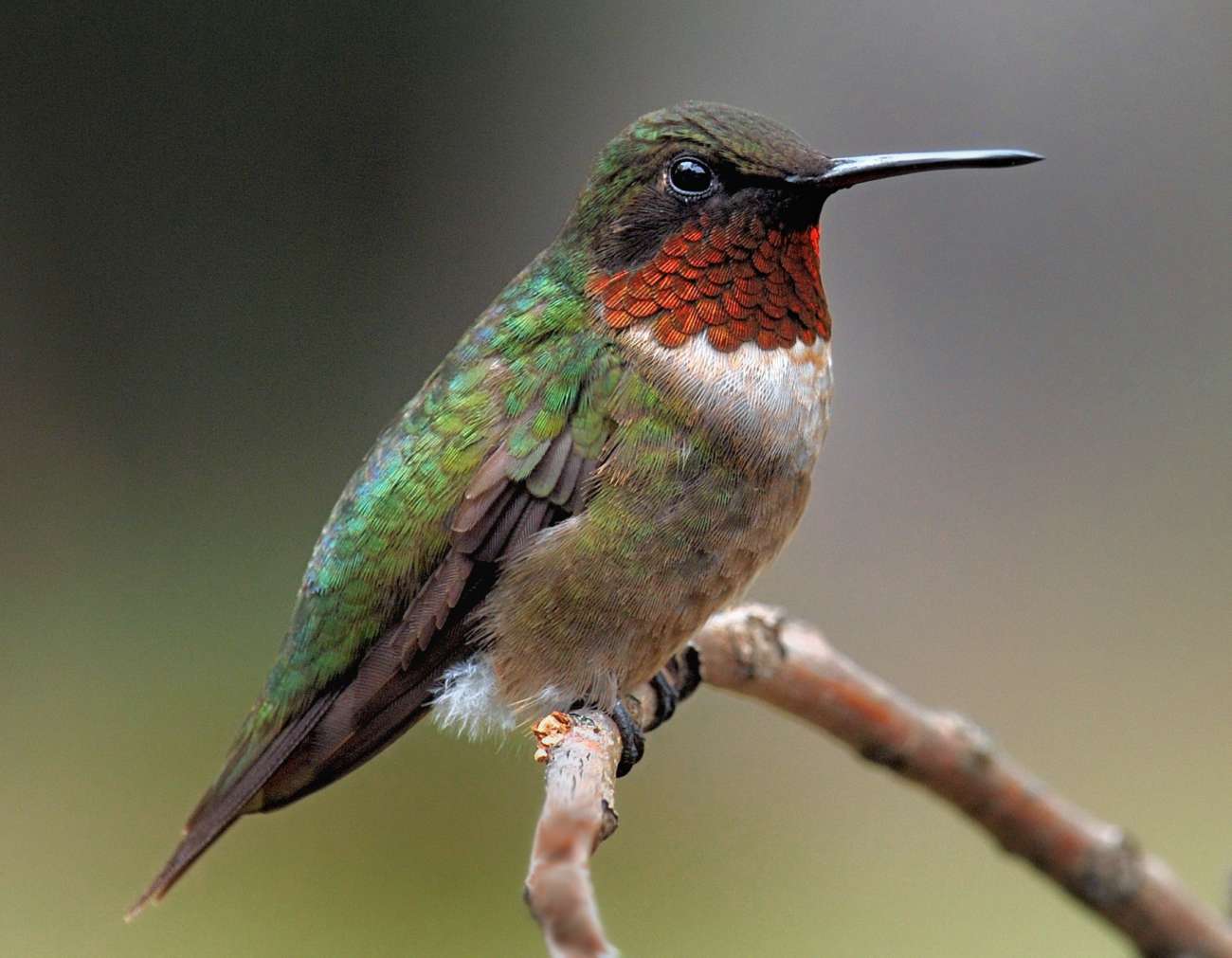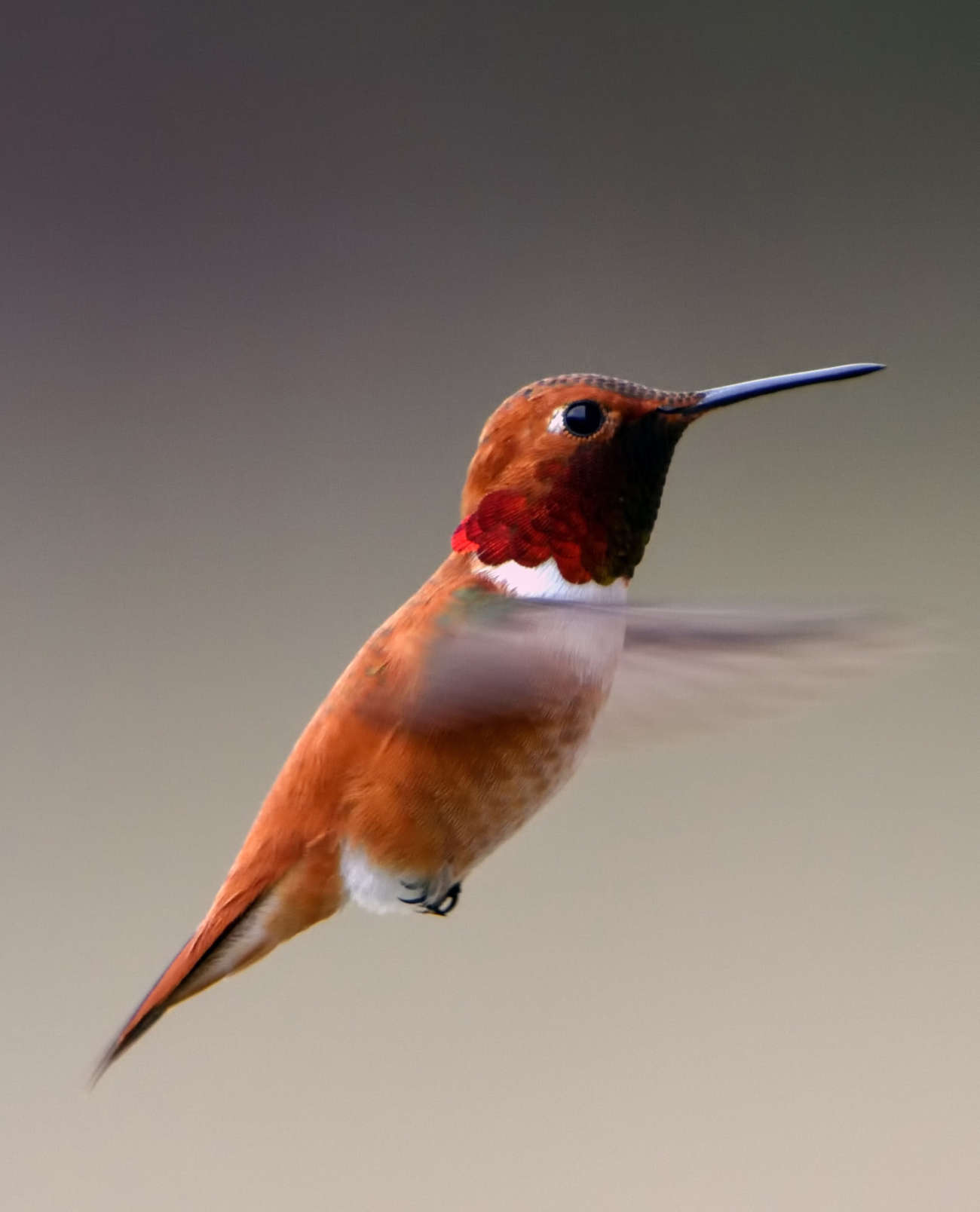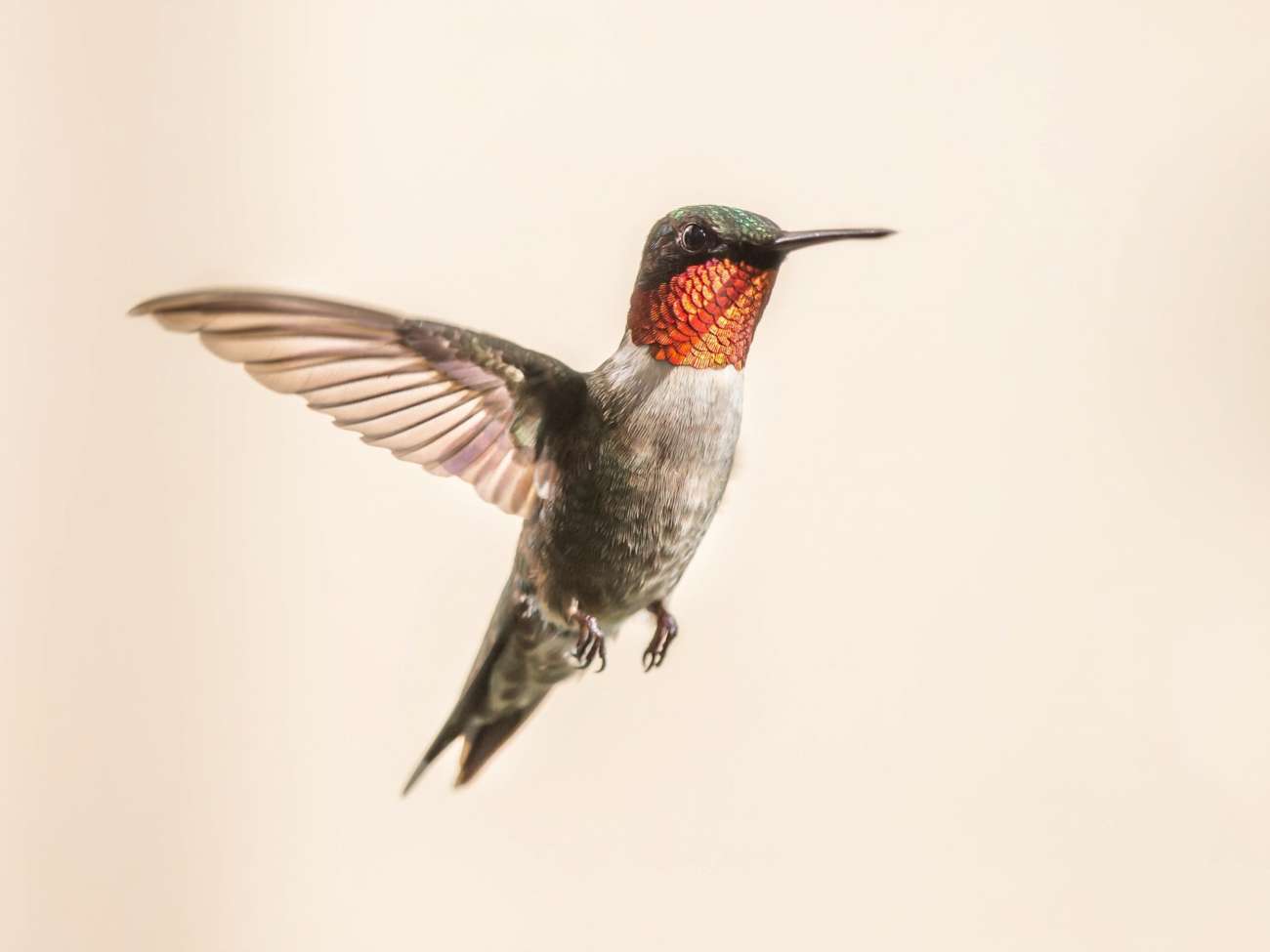Les Oiseaux

Les colibris sont les principaux oiseaux qui jouent un rôle dans la pollinisation en Amérique du Nord. Leur long bec et leur longue langue leur permettent d'extraire le nectar des fleurs tubulaires. Le pollen est transporté à la fois sur leur bec et sur leurs plumes. Les régions plus proches des tropiques, où le climat est plus chaud, abritent le plus grand nombre d'espèces de colibris et le plus grand nombre de plantes indigènes qui répondent à leurs besoins alimentaires. Le colibri à gorge rubis (Archilochus colubris) est la seule espèce commune en Ontario. Les colibris peuvent voir la couleur rouge, contrairement aux abeilles. De nombreuses fleurs tropicales cultivées comme plantes annuelles, ainsi que les plantes indigènes des lisières de forêts, attirent les colibris.
Les colibris jouent un rôle important dans la chaîne alimentaire, pollinisant une variété de plantes à fleurs, dont certaines sont spécifiquement adaptées à la pollinisation par les colibris.
Certains colibris tropicaux sont menacés, comme d'autres pollinisateurs, en raison de la perte de leur habitat et des changements dans la répartition et l'abondance des plantes nectarifères. Le changement climatique et la propagation d'espèces envahissantes pourraient aggraver ces problèmes pour les colibris à l'avenir.
Les colibris jouent un rôle important dans la chaîne alimentaire, pollinisant une grande variété de plantes à fleurs, dont certaines sont spécifiquement adaptées à la pollinisation par les colibris.
Certains colibris tropicaux sont menacés, comme d'autres pollinisateurs, en raison de la perte de leur habitat et des changements dans la répartition et l'abondance des plantes nectarifères. Le changement climatique et la propagation d'espèces envahissantes pourraient aggraver ces problèmes pour les colibris à l'avenir.
Comme tous les oiseaux, les colibris ont des besoins fondamentaux en matière d'habitat, notamment de la nourriture, de l'eau, un abri et de l'espace pour se nourrir et se reproduire, afin de prospérer. Que vous soyez impliqué dans la gestion de vastes superficies de terres publiques ou privées ou que vous entreteniez simplement un petit jardin ou une jardinière chez vous, vous pouvez les rendre attrayants pour nos colibris indigènes.
De nombreuses espèces de colibris sont migratrices et doivent trouver un habitat approprié tout au long de leurs routes migratoires, ainsi que dans leurs zones de reproduction, de nidification et d'hivernage. Les habitats longs et étroits, tels que les couloirs de service, les bordures de champs et les bords de routes, peuvent constituer des liaisons importantes entre des zones d'habitat plus vastes. Même les petites parcelles d'habitat situées le long de leur route migratoire peuvent être essentielles pour les oiseaux, car elles leur offrent des lieux de repos et de nourriture pour alimenter leur voyage.
Espèces et répartition

Il existe plus de 300 espèces de colibris dans le monde, toutes présentes uniquement dans l'hémisphère occidental, du sud-est de l'Alaska au sud du Chili. Bien que les colibris vivent dans des climats et des environnements très variés, on trouve beaucoup plus d'espèces dans les régions tropicales que dans les zones tempérées.
De nombreuses espèces de colibris d'Amérique du Nord sont migratrices et parcourent chaque année d'énormes distances entre leurs lieux de reproduction estivaux dans le nord et leurs zones d'hivernage dans le sud.
Le colibri roux (Selasphorus rufus), que l'on trouve sur la côte ouest du Canada, parcourt environ 6 000 kilomètres (aller simple) – la plus longue migration de colibri jamais enregistrée – et se reproduit plus au nord que tout autre colibri. Effectuant une boucle gigantesque, il se déplace vers le nord le long de la côte pacifique, depuis ses sites d'hivernage au Mexique jusqu'à ses sites de reproduction estivaux situés aussi loin au nord que l'Alaska, puis suit les montagnes Rocheuses lors de son voyage de retour vers le sud.
Le colibri à gorge rubis (Archilochus colubris) est le seul colibri présent dans l'est du Canada. Il traverse chaque année le golfe du Mexique lors de sa migration entre ses sites d'hivernage dans le centre du Mexique et ses sites de reproduction estivaux dans l'est des États-Unis et au Canada.
Notions fondamentales sur les colibris

ALIMENTATION
Les colibris se nourrissent pendant la journée du nectar des fleurs, notamment des plantes annuelles, vivaces, des arbres, des arbustes et des vignes. Ils se nourrissent en vol stationnaire ou, si possible, perchés. Ils mangent également des insectes, tels que les mouches des fruits et les moucherons, et consomment la sève des arbres lorsqu'elle est disponible. Ils obtiennent la sève des arbres à partir des puits creusés dans les arbres par les pics buveurs de sève et d'autres oiseaux et insectes perceurs de trous.
La meilleure façon de soutenir les colibris et autres pollinisateurs dans votre région est de planter des plantes nectarifères indigènes.
Consultez nos guides écorégionaux pour obtenir la liste des espèces de plantes nectarifères indigènes qui profitent aux colibris au Canada.
Envisagez d'installer des mangeoires pour colibris afin d'attirer et de soutenir les populations de colibris résidents et migrateurs. Certains scientifiques suggèrent que la présence de mangeoires peut avoir un impact sur la pollinisation naturelle des plantes et modifier le comportement des colibris. D'autre part, les mangeoires ont contribué à renforcer les populations de colibris en compensant la perte de nourriture et d'habitat causée par l'activité humaine, et la perturbation des processus naturels de pollinisation et de la santé des colibris est probablement négligeable lorsque les pratiques appropriées sont suivies.
- Les mangeoires de couleur rouge sont généralement les plus attrayantes pour les colibris.
- Placez la mangeoire dans un endroit ombragé, à au moins quelques mètres du sol et hors de portée des prédateurs tels que les chats errants.
- Il n'est pas nécessaire d'utiliser du nectar coloré, cela n'est pas indispensable pour attirer les colibris et ses effets sur leur santé sont inconnus.
- Remplissez-le d'eau purifiée et de 20 à 30 % de sucre raffiné (blanc) (jamais de saccharine, d'édulcorants artificiels, de miel ou de sucre brun). Il n'est pas nécessaire d'acheter de la « nourriture spéciale pour colibris », car il s'agit généralement d'eau sucrée coûteuse. Tout ce dont votre mangeoire a besoin, c'est de sucre blanc et d'eau.
- Nettoyez-la fréquemment pour éviter la fermentation ou la prolifération de champignons et de bactéries.
EAU
Les colibris s'hydratent suffisamment grâce au nectar et aux insectes qu'ils consomment. Cependant, ils sont attirés par l'eau courante, comme les fontaines, les arroseurs, les bains d'oiseaux avec brumisateur ou les cascades. De plus, les populations d'insectes sont généralement plus importantes près des étangs, des ruisseaux et des zones humides, ce qui fait de ces endroits des sources de nourriture importantes pour les colibris.
Menaces

PERTE D'HABITAT
Les colibris sont souvent particulièrement adaptés à leur environnement et à leurs sources de nourriture. Par conséquent, de nombreuses espèces de colibris sont extrêmement sensibles aux changements environnementaux et dépendent de la disponibilité continue de leur habitat préféré. En fait, toutes les espèces de colibris actuellement répertoriées comme vulnérables ou en voie de disparition sur la Liste rouge de l'UICN sont principalement menacées par la perte et la destruction de leur habitat. Bien qu'aucune espèce de colibri d'Amérique du Nord ne soit actuellement concernée par les efforts de conservation, celles qui sont menacées le sont principalement en raison de la conversion de leurs habitats naturels en terres agricoles en Amérique centrale et en Amérique du Sud.
CHANGEMENT CLIMATIQUE
Le changement climatique aura probablement des répercussions importantes sur les colibris en raison des modifications rapides des paysages naturels. Par exemple, certaines espèces de colibris ne vivent qu'au niveau de la mer (comme aux Bahamas), et une élévation du niveau de la mer d'un mètre pourrait donc les mener à l'extinction. De même, le changement climatique pourrait perturber les habitats naturels, en particulier ceux des espèces tropicales qui ont des aires de répartition restreintes et spécialisées. Le changement climatique devrait également accroître la pression exercée par les espèces envahissantes, comme décrit ci-dessous.
De plus, certains scientifiques ont affirmé que le réchauffement climatique pourrait modifier la phénologie des plantes à nectar essentielles, en particulier aux latitudes plus élevées, ce qui pourrait potentiellement affecter le succès de reproduction de certains colibris migrateurs. Cependant, des études supplémentaires sont nécessaires pour déterminer exactement comment ces changements phénologiques affecteront les populations de colibris.
ESPÈCES VÉGÉTALES ENVAHISSANTES
Les gens plantent souvent des plantes non indigènes pour leur valeur ornementale, mais ces espèces exotiques peuvent devenir envahissantes et rapidement supplanter les espèces indigènes locales. Planter des espèces non indigènes pour attirer les colibris peut perturber les écosystèmes et doit être évité. Consultez les guides des gestionnaires fonciers régionaux ci-dessous pour obtenir la liste des espèces végétales nectarifères indigènes qui profitent aux colibris dans l'ouest des États-Unis.
Dans de nombreuses régions, le changement climatique rapide modifie considérablement les conditions environnementales historiques, exerçant une pression accrue sur les plantes indigènes adaptées au milieu local et ouvrant la voie à des envahisseurs exotiques. Si les tendances actuelles se poursuivent, les espèces envahissantes contribueront probablement à des changements écologiques importants au niveau du paysage, avec des conséquences largement inconnues pour la faune sauvage.